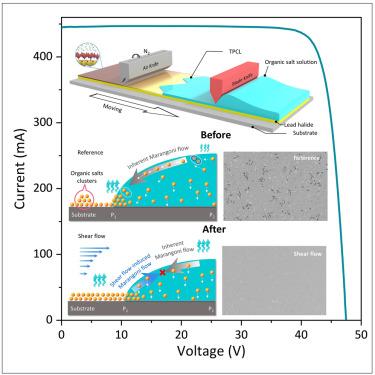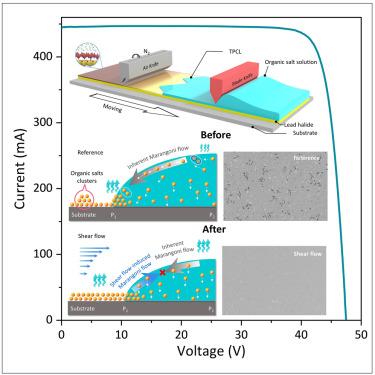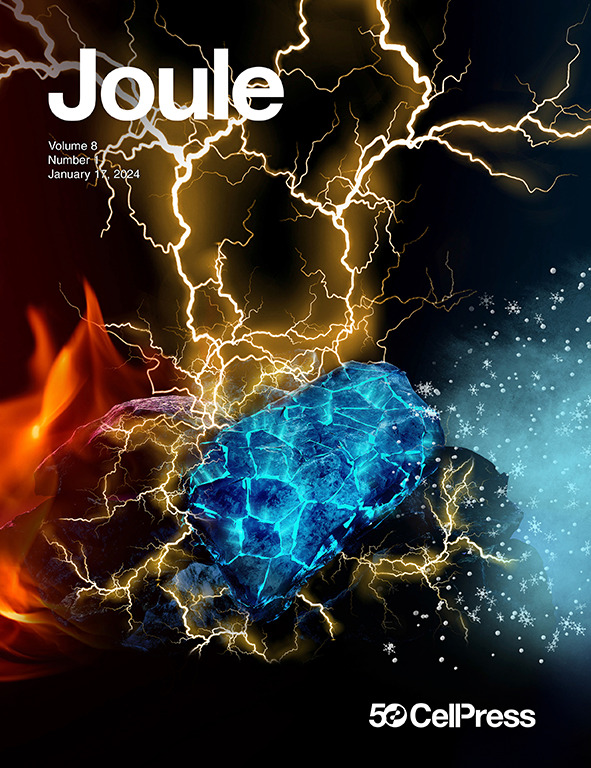钙钛矿太阳能电池和组件中有机材料涂层均匀性的剪切流策略
IF 35.4
1区 材料科学
Q1 CHEMISTRY, PHYSICAL
引用次数: 0
摘要
钙钛矿层的不均匀性是限制大面积钙钛矿太阳能电池(PSCs)性能提高的关键瓶颈。在蒸发-溶液混合方法中,由于涂层过程中局部有机物质浓度的变化,会产生Marangoni效应,导致材料聚集和咖啡环效应,从而影响器件性能。本文讨论了涂膜过程中的吹气过程,确定了剪切流是影响涂膜均匀性的关键因素。通过调节剪切流动强度,调节由局部浓度差异引起的表面张力梯度,减轻马兰戈尼效应,形成均匀的钙钛矿膜。因此,钙钛矿/硅串联太阳能电池(PS-TSCs)的效率为27.36%(孔径面积为64.64 cm2),而钙钛矿组件(psm)的效率为21.83%(孔径面积为810 cm2)。本文章由计算机程序翻译,如有差异,请以英文原文为准。


Shear flow strategy for coating homogeneity of organic materials in perovskite solar cells and modules
The non-uniformity of the perovskite layer is a critical bottleneck limiting performance improvements in large-area perovskite solar cells (PSCs). In the evaporation-solution hybrid method, the Marangoni effect occurs due to variations in local organic material concentration during the coating process, leading to material clustering and coffee-ring effects, which hinder device performance. Here, we discussed the air-blowing process during coating and identified shear flow as the key factor affecting film homogeneity. By modulating the shear flow intensity, the surface tension gradient induced by local concentration differences is adjusted, mitigating the Marangoni effect and resulting in uniform perovskite films. Consequently, perovskite/silicon tandem solar cells (PS-TSCs) achieved 27.36% efficiency (64.64 cm2 aperture area), whereas perovskite modules (PSMs) reached 21.83% efficiency (810 cm2 aperture area).
求助全文
通过发布文献求助,成功后即可免费获取论文全文。
去求助
来源期刊

Joule
Energy-General Energy
CiteScore
53.10
自引率
2.00%
发文量
198
期刊介绍:
Joule is a sister journal to Cell that focuses on research, analysis, and ideas related to sustainable energy. It aims to address the global challenge of the need for more sustainable energy solutions. Joule is a forward-looking journal that bridges disciplines and scales of energy research. It connects researchers and analysts working on scientific, technical, economic, policy, and social challenges related to sustainable energy. The journal covers a wide range of energy research, from fundamental laboratory studies on energy conversion and storage to global-level analysis. Joule aims to highlight and amplify the implications, challenges, and opportunities of novel energy research for different groups in the field.
 求助内容:
求助内容: 应助结果提醒方式:
应助结果提醒方式:


